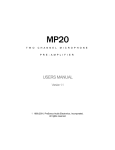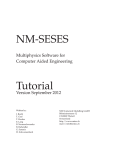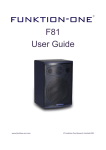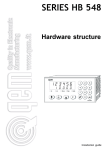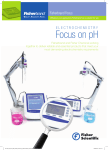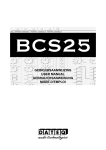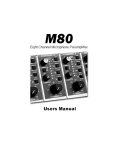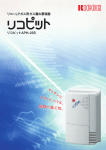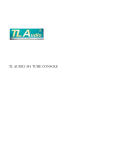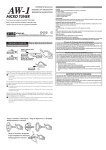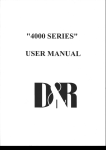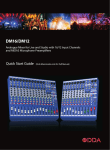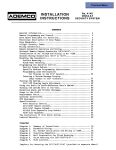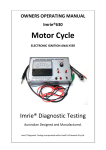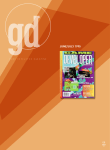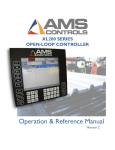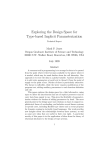Download FOH User Manual
Transcript
Forum FOH User Manual Klark Teknik Building Walter Nash Road Kidderminster Worcestershire DY11 7HJ Tel: +44 (0) 1562 741515 Fax: +44 (0) 1562 745371 Email: [email protected] Website: www.ddaconsoles.com Forum FOH User Manual Telex Communications (UK) Limited In line with the company’s policy of continual improvement, specifications and function maybe subject to change without notice. This Operator Manual was correct at the time of writing. E&OE. Contents DECLARATION OF CONFORMITY ......................................................... 3 INTRODUCTION ........................................................................................ 4 SAFETY PRECAUTIONS........................................................................... 5 TRANSPORT ............................................................................................... 6 ATTENTION ................................................................................................ 6 WARRANTY ................................................................................................ 7 SPECIFICATIONS ...................................................................................... 9 GLOSSARY ................................................................................................11 MODULE DESCRIPTIONS ...................................................................... 16 MONO INPUT MODULE ......................................................................... 18 MONO MUTE INPUT ............................................................................... 23 STEREO INPUT MODULE ...................................................................... 25 THE STEREO MUTE INPUT MODULE ................................................. 31 THE DUAL EFFECT RETURN MODULE .............................................. 32 6 INTO 1 MICROPHONE INPUT ............................................................ 34 THE DIGITAL STEREO INPUT MODULE ............................................. 36 10 WAY SELECTOR MODULE ............................................................... 41 THE STANDARD OUTPUT MODULE ................................................... 44 THE MATRIX OUTPUT MODULE ......................................................... 49 COMPOSER OUTPUT MODULE ............................................................ 53 STEREO MASTER MODULE .................................................................. 57 GENERAL SERVICING............................................................................ 61 POWER SUPPLY ....................................................................................... 62 FORUM OPERATION AND MAINTENANCE MANUAL 9601 PAGE 2 Declaration of Conformity The Manufacturer of the Products covered by this Declaration is Klark Teknik Building, Walter Nash Road, Kidderminster, Worcestershire, DY11 7HJ. The Directives Covered by this Declaration. 89/336/EEC Electromagnetic Compatibility Directive, amended by 92/31/EEC & 93/68/EEC 73/23/EEC Low Voltage Equipment Directive, amended by 93/68/EEC. The Products Covered by this Declaration. Equipment type Product Name Variants Audio Mixing Console Q2 Q2 VCA Audio Mixing Console Q2 Monitor Meterbridge Audio Mixing Console QMR Meterbridge Audio Mixing Console FMR Audio Mixing Console Forum PA,Matrix,Mute Audio Mixing Console Forum Monitor Meterbridge Audio Mixing Console XL200 Audio Mixing Console XL250 The Basis on which Conformity is being Declared The products identified above comply with the protection requirements of the EMC Directive and with the principal elements of the safety objectives of the Low Voltage Directive, and the manufacturer has applied the following standardsQ EN 55013 Q 1990 Limits and methods of measurement of radio disturbance characteristics of Broadcast Receivers and Associated Equipment. EN 50082-1 Q 1992 Electromagnetic Compatibility - Generic Immunity Standard Part 1. Residential, commercial and light industry. EN 60065 Q 1994 Safety requirements for mains operated electronic related apparatus for household and similar general use. The technical documentation required to demonstrate that the products meet the requirements of the Low Voltage Directive has been compiled by the signatory below and is available for inspection by the relevant enforcement authorities. The CE mark was first applied in 1996. SignedQ ................................ AuthorityQ Product Support Manager. G.M.Squires DateQ 1st, January 1997. Attention The attention of the specifier, purchaser, installer, or user is drawn to special measures and limitations to use which must be observed when these products are taken into service to maintain compliance with the above directive. Details of these special measures and limitations to use are available on request, and are also contained in product manuals. FORUM OPERATION AND MAINTENANCE MANUAL 9601 PAGE 3 INTRODUCTION The Forum console is a high quality console, designed for use in live sound and recording applications. Two output modulesR a standard output module and a matrix output module are available, along with a number of input modules as follows Q! ! ! ! ! ! mono standard input and mono mute input stereo input and stereo mute input dual effect return digital stereo input 10 way selector 6 into 1 microphone module The Forum is normally supplied as a FORUM P.A. or as a FORUM MATRIX and the frame will accommodate up to 60 modules. Normally the master module, a double blank module and the 8 output modules will occupy 12 of those positions with the remainder being available for input modules. An 8 module wide frame extender can be fitted where additional modules are required on an existing console or to increase the maximum frame size to 68 modules. FORUM OPERATION AND MAINTENANCE MANUAL 9601 PAGE 4 SAFETY PRECAUTIONS IMPORTANT - PLEASE READ BEFORE INSTALLING YOUR FORUM CONSOLE Strong sources of electromagnetic radiation e.g. high power cabling, video monitors and radio transmitters may cause degradation of of the audio quality due to induced voltages in the chassis and connection leads. Site the console away from such sources. For the same reason it is advisable to site the power supply away from the console. ! Electronic components are susceptible to conditions of excessive heat or extreme cold so take care not to use your console under such conditions. ! Before powering up the console make sure that the power supply voltage selection matches the local mains supply. ! Never connect or disconnect the power cable with out switching off the power supply. Similarly switch of the console before removing or servicing modules. ! Do not attempt to wipe clean the console with a cleaning liquid. Most surfaces can be simply cleaned with a soft dry brush. Should the chassis or channel ident strips need cleaning use only water or an alcohol. Solvent based products should not be used as they will damage these parts. If you spill any liquids in the console e.g. coffee on the faders switch off the power supply immediately. Consult you authorised dealer before attempting any cleaning. FORUM OPERATION AND MAINTENANCE MANUAL 9601 PAGE 5 TRANSPORT We recommend that you retain all the packing from your FORUM console should you ever need to return it for service or move the console to other prenises. If the console has to be moved regularly then we suggest that you purchase a foam lined flight case available from your distributor if you cannot purchase one locally. Only use the power supply and cables provide. Your warranty is invalidated if other supplies or cables are used. If you experience any problem with the local mains, or during thunder storms, switch off the power supply and unplug it from the mains supply. ATTENTION CABLES This product should only be used with high quality, screened twisted pair audio cables, terminated with metal bodied 3-pin XLR connectors. The cable shield should be connected to Pin 1. Any other cable type or configuration for the audio signals may result in degraded performance due to electromagnetic interference. ELECRIC FIELDS Should this product be used in an electromagnetic field that is amplitude modulated by an audio frequency signal P20Hz 20Khz), the signal to noise ratio may be degraded. Degradation of up to 60dB at a frequency corresponding to the modulation signal may be experienced under extreme conditions P3V/m, 90% FORUM OPERATION AND MAINTENANCE MANUAL 9601 PAGE 6 WARRANTY If within a period of twelve months from the date of delivery of the equipment to the End User it shall prove defective by reason only of faulty materials and/or workmanship Pbut no faulty design) to such an extent that the effectiveness and/or the usability thereof is materially affected, the Equipment or the faulty component shall be returned to the Distributor or DDA and subject to the following conditions the Distributor or DDA will repair or at its option replace the defective components. Any components replaced will become the property of DDA. Any Equipment or component returned will be at the risk of the End User whilst in transit Pboth to and from the Distributor or DDA) and postage and/or freight charges must be prepaid. This Warranty shall only be available ifQi) The Equipment has been properly installed in accordance with the instructions contained in this manual. ii) The End User has notified the Distributor or DDA in writing within 14 days of the defect appearing. iii) No persons other than authorised representatives of DDA or the Distributor have effected any replacement of parts, maintenance adjustments or repairs to the Equipment. iv) The End User has used the Equipment for such purposes as DDA recommends with only such operating supplies as meet DDAís specifications or approval and otherwise in all respects in accordance with DDAís recommendations. Defects arising as a result of the following are not covered by this Warranty Q Faulty or negligent handling, chemical or electro-chemical or electrical influences, accidental damage, Acts of God, neglect, defficiency in electrical power, air conditioning or humidity control. FORUM OPERATION AND MAINTENANCE MANUAL 9601 PAGE 7 Benefit of this Warranty may not be assigned by the End User. End Users who are consumers should note that their rights under this Warranty are in addition to and do not affect any other rights to which they may be entitled against the seller of the Equipment. DDA shall not be liable for any damage caused to persons or property due to Qi) ii) Incorrect usage of the Equipment Other equipment attached to the Equipment, which is not approved by DDA iii) Modifications made by non-authorised persons, or by using non-recommended parts, or incorrectly made. In no circumstances shall DDA be liable for any indirect or consequential costs, damages or losses Pincluding loss of business profits, operating time or otherwise) arising out of the use or inability to use the product, whether or not the likelihood of damage was advised to DDA or its distributor. Fuses and lamps are specifically excluded from this warranty. This notice does not affect your statuatory rights. FORUM OPERATION AND MAINTENANCE MANUAL 9601 PAGE 8 SPECIFICATIONS Note Q All specifications relate to dBu, ie 0dBu = 0.775V RMS Maximum Gain Mic Input to Mix OutputQ Line Input to Mix OutputQ 86dB 30dB Frequency Response Mic Input to Mix OutputQ Pgain 55dB) 20Hz , -0.50dB 20kHz, -0.20dB Line Input to Mix Output Pgain 0dB) 20Hz , -0.50dB 20kHz, -0.20dB Noise, DIN Audio Weighted Microphone Input Gain 55dB, EIN Ref 200 Ohm S-127.5dBu Line Input to Mix Output Gain 0dB, 16 inputs routed S-84dBu Distortion Microphone Input to Mix Output -50dBu input, +4dBu output S0.005% Line Input to Mix Output +4dBu input, +4dBu output S0.005% Crosstalk Adjacent Channel, 1kHz S-100dBu Group to Mix, 1kHz S-78dBu Fader Attenuation, 1kHz S-85dBu Panpot Isolation, 1kHz S-72dBu FORUM OPERATION AND MAINTENANCE MANUAL 9601 PAGE 9 LED Bargraph Metering P20 segment) Rise Time to 0dBu Peak Q 1mS Average Q 150mS Release Time to -20dBu Peak Q 2 S Average Q 250mS Accuracy Prelative to 0dB) +/-0.5dB Forum Power Supply specifications AC Mains Voltage selectionQ Internal link settings for 90V, 100V, 120V, 220V, 230V, and 240V Power Consumption Pmax) Q AC Mains frequency Q 50Hz...60Hz Fuse ratingsQ 220/230/240V - 6.3A 90/100/120V - 10A Cooling MethodQ Internal fan DC Power OutputsQ +17 Volts, 6A max -17 Volts, 6A max +48 Volts, 0.35A max FORUM OPERATION AND MAINTENANCE MANUAL 9601 PAGE 10 GLOSSARY This section provides a simple explanation of some of the terms used when describing the console features. ìAî GAUGE JACK This is a 1/4O jack which has a large tip diameter compared with a ìBî gauge jack which has a smaller diameter tip and is usually found in broadcast use. AFL After fade listen. For listening to post fade signals. AUXILIARY SENDS These are extra signal paths out of the console which are separate from the main mix and group outputs. Each auxiliary output is like a separate mixer and can be controlled independently of the main faders. They are used to provide special mixes to artistes as they are recording Pnormally called FOLDBACK) or as a signal to be sent to an effect such as a reverberation or delay device. BUS This is the term used to describe the summing or mixing of a number of signals. A number of signals routed to the same bus will appear as one signal at the output of the bus mixing amplifier. BUS TRIM A control used to adjusted the level of all signals going to a Group Output. CHANNEL PATH The path used by the signal going to tape in an in-line console. D.I. Direct Inject is an input used for high level devices such as keyboards where the line input would not be sensitive enough. DIM This reduces the monitor level by a preset amount, usually 20dB in DDA products. FORUM OPERATION AND MAINTENANCE MANUAL 9601 PAGE 11 DIRECT OUTPUT This refers to the individual output of a channel which is available even if the channel is not routed. EBO Electronically Balanced Output. EQ Equalizer or Tone Control. FOLDBACK This is the signal which is usually fed to the artistes headphones. GROUND SENSING OUTPUT An output stage where any ground noise is injected into the feedback loop in such a way that it appears on the amplifier output. As the ground should be the reference for the following stage, if it is moving and the signal is moving in the same way then no net signal results. GROUP OUTPUT An output usually routed to a multi-track tape recorder input. This output is derived from a bus and one group output stage is required for each bus. PDMR12 excepted) HF High Frequency HIGH PASS FILTER A filter which cuts out frequencies below its operating frequency. It can be used to filter out rumble picked up by a microphone for example. INSERT POINT Sometimes referred to as a patch point. This is an interruption to the signal path to allow for the insertion of a signal processing device. In an in-line console such as the DCM it can be in either the mix or channel path Pswitchable). FORUM OPERATION AND MAINTENANCE MANUAL 9601 PAGE 12 LF Low Frequency. LINE INPUT An input designed to accept high level signals as opposed to microphone level signals. The expected level is usually +4dB but increasingly inputs and outputs are being designed so that they can be altered to operate at -10dBV which is now quite a common operating level. LOW PASS FILTER This is the inverse of a HIGH PASS filter and is used to reduce frequencies above the operating frequency MASTER This normally refers to the main stereo output section which controls the level of the stereo mix and associated functions such as monitoring. MIX PATH The path used by the signal going to the stereo mix. PARAMETRIC EQ An equaliser section which has variable frequency, level and Q. PAN A pan control or Pan Pot or Panoramic Potentiometer is used to spread a mono signal across a stereo bus. In the centre the signal is reduced by 4.5dB to compensate for the effects of summing to mono. PEAKING EQ In this form of equaliser the response is tailored to enhance a selected frequency relative to the frequencies above and below it. Peaking equalisers are normally used as the mid sections of an equaliser. PFL Pre-fade listen. For listening to pre fade signals. FORUM OPERATION AND MAINTENANCE MANUAL 9601 PAGE 13 PRE A signal derived before a fader and therefore not dependant upon the position of the fader. POST A signal derived after a fader and therefore dependant upon the position of the fader. Q Associated with peaking equalisers the Q is the factor which describes how wide the peak or trough of enhancement is. The smaller the Q the wider the bandwidth of the equaliser will be. Typically a fixed Q equaliser will have a Q of about 1.5 equating to a bandwidth of about 1 octave. QUASI BALANCED An arrangement whereby a bus is terminated with a differential input. The bus however is not truly balanced, instead a bus common is used to pick up any interference which will also be picked up by the true bus. The interference then appears as a common mode signal at the mixing amplifier. RETURN Any signal that is sent out of the console and is returned after some form of processing. ROUTING The sending of a signal to a bus normally by pressing a switch. Signal can be routed to several buses simultaneously if required. SEND The output from a channel insert point is called the send. SHELVING EQ This means that the response of the equaliser becomes constant after the turnover or corner frequency has been passed. Thus a high frequency shelving equaliser operating at 10k will have a rising response as the frequency approaches 10k but will be flat after 10k. This is normally used on the high and low frequency sections of an equaliser. FORUM OPERATION AND MAINTENANCE MANUAL 9601 PAGE 14 SLATE The ability to talk to tape from the operating position of the console. On the DCM it is possible to slate both the multi-track group outputs and the stereo mix bus. SIP Solo in Place SWEEP FREQUENCY A control which selects a centre frequency to operate around. Most often used with peaking equalisers but it can also be used to determine the roll off point of shelving EQs as well. VCA Voltage Controlled Amplifier. An amplifier whose gain can be controlled by a DC Voltage applied to its control port. XLR The XLR Pin fact a specific manufacturer's model reference) is an industry standard connector of high quality and is normally used for balanced signals, primarily microphones and balanced outputs. The most common is a three pin version, although there are types with more pins for ther purposes. FORUM OPERATION AND MAINTENANCE MANUAL 9601 PAGE 15 MODULE DESCRIPTIONS The input modules are provided with rear panel connectors for Microphone Pon XLR), and Line Pjack), both balanced. Insert send and return signals are available on a single stereo jack socket, and are unbalanced. A Direct Output, unbalanced and ground sensing, is also available via a jack socket on the rear panel. Wiring of the XLR and jack connectors follows normal conventions, so that compatibility with existing cables is provided where possible. XLRQ Pin 1 Pin 2 Pin 3 Ground Signal +ve Phot) Signal -ve Pcold) Jack Line Insert Direct Output Tip Ring Sleeve Hot P+ve) Cold Ground Send Return Ground Hot P+ve) Ground Sense Ground Blanking panels are fitted to the main chassis to allow the fitting of multiway connectors. Consult your authorised dealer for more information. All balanced XLR inputs are wired to the international standard of Pin 2 HOT. If you need to connect unbalanced equipment to inputs or outputs, wire the cold terminal to Pin 3 for XLRs or the Ring for jacks. The microphone input is suitable for use with balanced, low impedance microphones P150-200 ohms). Do not use dynamic, unbalanced or battery powered microphones with the +48 volt phantom power switched on damage to the microphone may result. The gain of this section is variable from 6dB to 76dB, to give an output of +4dB at the stereo mix outputs. This corresponds to a sensitivity of -2dBu to -72dBu. FORUM OPERATION AND MAINTENANCE MANUAL 9601 PAGE 16 With the gain control at minimum, the maximum input level is +14dBu without the 20dB pad. The gain of the line input may be adjusted from -10dB to +20dB corresponding to a sensitivity of +14dBu to -16dBu to give an output of +4dBu at the stereo mix outputs. The impedance of the line input is approximately 20Kohms, so instruments with high impedance outputs such as electric guitars are best fed through a DI box to the microphone input to avoid being loaded down by the line input impedance. . FORUM OPERATION AND MAINTENANCE MANUAL 9601 PAGE 17 MONO INPUT MODULE +48V Provides 48 volt phantom power for a condenser microphone, or DI box. Optional balancing transformers may be fitted on the Mic input. PAD Switching in PAD inserts a 20dB attenuator in circuit with the microphone input. This may be used when high-output microphones are employed, or to enable the use of the mic input for line-level signals. GAIN The gain control is a wide range rotary potentiometer, and is active on both Mic and Line Inputs. On Mic, the gain can be adjusted from 6dB to 76dB. For Line inputs, the adjustment is from -10dB to +20dB. LINE The LINE switch selects the signal on the line input socket to feed the channel path when it is down. In this case, the Mic signal is disconnected. The PHASE REVERSE switch inverts the phase of the selected input, Mic or Line, to allow compensation for different wiring standards. FILTER The Filter switch inserts a 80Hz highpass filter with a rolloff of 12dB per octave into circuit after the input amplifier. This may be used to eliminate unwanted low-frequency noises such as rumble, or camera buzz. FORUM OPERATION AND MAINTENANCE MANUAL 9601 PAGE 18 EQUALISER The equaliser on the mono input module is a four band design, incorporating two sweepable peaking mid-range sections and fixed frequency shelving high and low controls. HF Shelving section, providing +/-15dB of gain at 12kHz. HI MID Peaking section, providing +/- 15dB of gain, at frequencies from 470Hz to 15kHz. LO MID Peaking section, providing +/- 15dB of gain, at frequencies from 70Hz to 2.2kHz. LF Shelving section, providing +/- 15dB of gain at 50Hz. EQ IN The EQ switch inserts the entire equaliser circuit into circuit. When switched out, the equaliser is totally bypassed, keeping the signal path to a minimum. The Insert point is located after the EQ section. FORUM OPERATION AND MAINTENANCE MANUAL 9601 PAGE 19 AUXILIARIES The Forum console has six auxiliary buses, accessed on the Standard Input module from 4 controls. In addition, the channel direct output may be controlled via one pot, to provide extended auxiliary sends. AUX 1 Controls the level of the channel signal fed to the Aux 1 bus. This signal is normally post-fader, unless the PRE button, just below, is depressed. DIR Re-routes the signal on the Aux 1 control to feed the Channel Direct output. The signal no longer feeds the Aux 1 bus, and can be used either as an additional single effects send, or as a feed to a multitrack, for example. PRE Feeds the Aux 1 and Aux 2 controls with a signal taken pre-fader, instead of post-fader. In this case, the signal on the Aux 1 & 2 buses is unaffected by the position of the channel fader. AUX 2 Controls the level of the channel signal fed to the Aux 2 bus. This signal is normally post-fader, unless the PRE button, just above, is depressed. AUX 3 Controls the level of the channel signal fed to the Aux 3 bus, and is internally linkable to be pre or post-fader. When the 5-6 switch is depressed, this control feeds the Aux 5 bus instead of the Aux 3 bus. AUX 4 Controls the level of the channel signal fed to the Aux 4 bus, and is internally linkable to be pre or post-fader. When the 5-6 switch is depressed, this control feeds the Aux 6 bus instead of the Aux 4 bus. NoteQ DIR, PRE, and 5-6 are local to the module, they do not affect signal flow on any other module than the one on which they are located. FORUM OPERATION AND MAINTENANCE MANUAL 9601 PAGE 20 ROUTING AND STATUS MIX Routes the post-fade, post-pan channel signal to the stereo mix bus. 1-2 P3-4, 5-6, 7-8) Routes the post-fade, post-pan channel signal to output buses 1 and 2 P3 & 4, 5 & 6, 7 & 8). PAN When PAN is set to centre, equal levels are sent to both buses, with a 4.5dB drop relative to fully clockwise or anti-clockwise. Setting the PAN control fully anticlockwise sends full level to the Left/1/3/ 5/7buses, cutting the send to the Right/2/4/6/8 busesR fully clockwise rotation sends full level to the Right/2/4/6/8 buses, cutting the feed to Left/1/3/5/7. ON The ON switch enables the channel signal path, and is indicated by an led in the switch when the channel is active. When OFF, all post-fade auxiliary sends and routing assignments are muted. PFL The PFL button Por SOLO) feeds the post-EQ, pre-fader signal to the Monitor section Ploudspeakers or headphones), replacing the selected monitor source. The main stereo output of the console is not affected. The red led in the PFL switch will illuminate when the PFL function is active. PFL signals from different sources that are active simultaneously will be summed. A five segment led signal meter shows when signal is present, above a threshold of -13dBu, and will show peak signals up to +17dBu. If the top led is on partly or continuously, the signal is close to clipping, or severe distortion, and the channel gain should be reduced. The fader is the main signal level control for the channel, and is a long-throw type which gives smooth control of the channel level. FORUM OPERATION AND MAINTENANCE MANUAL 9601 PAGE 21 CONNECTORS AND PIN DEFINITIONS Mic Input Q 3 Pin XLR type, Balanced Nominal Input LevelQ -72dBu to -2dBu Pin 2 Q Signal +ve PHot) Pin 3 Q Signal -ve PCold) Pin 1 Q Ground Input Impedance Q >2 kOhm Line Input Q 1/4O TRS Jack Socket, ëAí Gauge, Balanced Nominal Input LevelQ -16dBu to +14dBu Tip Q Signal +ve PHot) Ring Q Signal -ve PCold) Sleeve Q Ground Input Impedance Q >10 kOhm Insert Point Q 1/4O TRS Jack Socket, ëAí Gauge, Unbalanced Nominal Input/Output levelQ -2dBu Tip Q Insert Send Ring Q Insert Return Sleeve Q Ground Output ImpedanceQ S75 Ohm Input Impedance Q >10 kOhm Direct Output Q1/4O TRS Jack Socket, ëAí Gauge, Ground Compensated Nominal Output levelQ -2dBu Tip Q Signal Ring Q Signal Ground PGround Compensated) Sleeve Q Ground Output ImpedanceQ S75 Ohm FORUM OPERATION AND MAINTENANCE MANUAL 9601 PAGE 22 MONO MUTE INPUT The input and equaliser sections on this module are the same as those on the Mono Standard Input Module. The differences occur in the remainder of the module as follows. AUXILIARIES 1 and 2 Independent level control is provided for these two auxiliaries with a common switch to select the prefade signal as the source. Internal jumpers are available to further select the prefade signal between the pre and post equaliser signal. Auxiliary 1 can be used to control the direct output of the channel by depressing the DIR button. If PRE is also selected then the direct output will be independent of the channel fader position and can be totally controlled by the AUX 1 level control. AUXILIARIES 3 and 4 Independent level control is provided for these two auxiliaries with a common switch to select the prefade signal as the source. Internal jumpers are available to further select the prefade signal between the pre and post equaliser signal. AUXILIARIES 5 and 6 Independent level control is provided for these two auxiliaries with a common switch to select the prefade signal as the source. Internal jumpers are available to further select the prefade signal between the pre and post equaliser signal. ROUTING Independent routing is provided to the 8 audio groups and the PAN control can be used to pan signal across odd and even buses. MUTE GROUPS There are 8 mute group switches which will assign the channel to one or more of the 8 mute groups. The mute grouping is independent of the audio grouping and a mute group can of course traverse audio groups. Thus when a master mute is operated all channels assigned to that mute group will cut although they may be assigned to different audio groups. The muting on this module is carried out electronically and thus there is the possibility of using other remote control systems such as the DDA Midi Mute system. The SAFE button can be used to prevent a channel from responding to a master mute without de-assigning it. FORUM OPERATION AND MAINTENANCE MANUAL 9601 PAGE 23 CONNECTORS AND PIN DEFINITIONS Mic Input Q 3 Pin XLR type, Balanced Nominal Input LevelQ -72dBu to -2dBu Pin 2 Q Signal +ve PHot) Pin 3 Q Signal -ve PCold) Pin 1 Q Ground Input Impedance Q >2 kOhm Line Input Q 1/4O TRS Jack Socket, ëAí Gauge, Balanced Nominal Input LevelQ -16dBu to +14dBu Tip Q Signal +ve PHot) Ring Q Signal -ve PCold) Sleeve Q Ground Input Impedance Q >10 kOhm Insert Point Q 1/4O TRS Jack Socket, ëAí Gauge, Unbalanced Nominal Input/Output levelQ -2dBu Tip Q Insert Send Ring Q Insert Return Sleeve Q Ground Output ImpedanceQ S75 Ohm Input Impedance Q >10 kOhm Direct Output Q1/4O TRS Jack Socket, ëAí Gauge, Ground Compensated Nominal Output levelQ -2dBu Tip Q Signal Ring Q Signal Ground PGround Compensated) Sleeve Q Ground Output ImpedanceQ S75 Ohm FORUM OPERATION AND MAINTENANCE MANUAL 9601 PAGE 24 STEREO INPUT MODULE The Stereo Input module has two stereo input sources. Input A is for a stereo Microphone, while input B is for a line-level stereo input, which can be optionally configured as a phono PRIAA equalised) input by purchasing the RIAA adapter card. Sum-and-Difference, or MS decoding is provided either at Mic or line level signals using a combination of the mono and phase reverse switches. +48V Switches 48 volt phantom power to the Mic input A. INPUT B Selects the source on the input B connectors. Normally this is a line input, but may be internally adapted to be a phono input from a turntable using the RIAA adapter. GAIN The Gain control is wide range rotary control, and is active on both inputs A and B. On input A PMic), the gain is adjustable from 16 to 66dB, while on input B PLine or Phono), the gain range is from -10 to +20dB. LEFT CUT This switch mutes the left channel signal, so only the right channel signal is heard. RIGHT CUT This switch mutes the right channel signal, so only the left channel signal is heard. MONO When both Left Cut and Right Cut switches are pressed, the input signal is combined to give a mono signal, which is fed to both signal paths through the module. PHASE REVERSE Under normal conditions, this reverses the phase of the right channel. If both the CUT switches above are pressed, additionally pressing Phase Reverse will allow the input to be used for MS decoding, either from a microphone or line level signal. FORUM OPERATION AND MAINTENANCE MANUAL 9601 PAGE 25 EQUALISER The equaliser on the stereo input module is a four-band design with two swept mids, and shelving high and low frequencies. HF Shelving section, providing +/-15dB of gain at 12kHz. HI-MID Peaking section, providing +/-15db of gain, at a centre frequency adjustable from 470Hz to 15kHz. LO-MID Peaking section, providing +/-15db of gain, at a centre frequency adjustable from 95Hz to 1.1kHz. LF Shelving section, providing +/-15dB of gain at 50Hz. Auxiliaries The FORUM console has six Auxiliary buses, accessible on the input module via 4 controls. On the Stereo Input module, the Aux buses are fed from a mono sum of the left and right channels. FORUM OPERATION AND MAINTENANCE MANUAL 9601 PAGE 26 AUX 1 Controls the level of the channel signal fed to the Aux 1 bus. This signal is normally post-fader, unless the PRE button just below the AUX 1 control is pressed. PRE Feeds the AUX 1 control with a signal taken pre-fader instead of post-fader. In this case, the signal fed to the Aux 1 bus is unaffected by the position of the channel fader. AUX 2 Controls the level of the channel signal fed to the Aux 2 bus. This signal is normally post-fader, unless the PRE button just above the AUX 2 control is pressed. PRE Feeds the AUX 2 control with a signal taken pre-fader instead of post-fader. In this case, the signal fed to the Aux 2 bus is unaffected by the position of the channel fader. AUX 3 Controls the level of the channel signal fed to the Aux 3 bus, and can be linked internally to be pre or post-fader. When the 5-6 switch is pressed, this control feeds the Aux 5 bus. AUX 4 Controls the level of the channel signal fed to the Aux 4 bus, and can be linked internally to be pre or post-fader. When the 5-6 switch is pressed, this control feeds the Aux 6 bus. FORUM OPERATION AND MAINTENANCE MANUAL 9601 PAGE 27 ROUTING When any routing button is pressed, the BAL control is automatically inserted into circuit, allowing the signal to be balanced in the stereo image. If the channel is selected to mono Psee Left/Right Cut switches) the Balance control will operate in a similar manner to the Pan control on mono inputs, but with a limited range of control P+/-3dB). MIX Routes the post-fade, post-bal signal to the stereo mix bus. 1-2 Routes the post-fade, post-bal signal to output buses 1 and 2. 3-4 Routes the post-fade, post-bal signal to output buses 3 and 4. 5-6 Routes the post-fade, post-bal signal to output buses 5 and 6. 7-8 Routes the post-fade, post-bal signal to output buses 7 and 8. BAL When BAL is set to its centre, equal levels are sent to both buses, with a 3 dB drop relative to fully clockwise or anti-clockwise. Setting the BAL control fully clockwise sends a level of 3dB higher on the right bus and a level of 3dB lower on the left bus. FORUM OPERATION AND MAINTENANCE MANUAL 9601 PAGE 28 ON The ON switch enables the channel signal path, and is indicated by an LED in the switch when the channel is active. When OFF, all post-fade auxiliary sends and routing assignments are muted. PFL The PFL button Por SOLO) feeds the post-EQ, pre-fader signal to the monitor section Ploudspeakers or headphones), replacing the master signal. The main stereo output is not affected. The red LED in the PFL switch illuminates when the PFL function is active.PFL signals from different sources that are active simultaneously are summed. SIGNAL METER PLED) A five segment LED signal meter shows when a signal is present above a threshold of -13dBu, and will show peak signals of up to +17dBu. If the top led is on partly or continuously, the signal is close to clipping. The meter shows the higher of the left or right channel signals. STEREO FADER The fader is the main signal level control for the channel, and is a long-throw type which gives smooth control of the channel level. FORUM OPERATION AND MAINTENANCE MANUAL 9601 PAGE 29 CONNECTORS AND PIN DEFINITIONS Input AQ Mic Input Q 3 Pin XLR type, Balanced Nominal Input LevelQ -72dBu to -2dBu Pin 2 Q Signal +ve PHot) Pin 3 Q Signal -ve PCold) Pin 1 Q Ground Input Impedance Q >2 kOhm Input BQ Line Q 1/4O TRS Jack Socket, ëAí Gauge, balanced Nominal Input levelQ -16dBu to + 14dBu Tip Q Signal +ve PHot) Ring Q Signal -ve PCold) Sleeve Q Ground Input ImpedanceQ >10 kOhm Input B can also accept Phono PRIAA) signals with the optional RIAA card fitted. RIAA Input sensitivity Q 2mV at maximum gain RIAA Input Impedance Q 47 kOhm / 100pF FORUM OPERATION AND MAINTENANCE MANUAL 9601 PAGE 30 THE STEREO MUTE INPUT MODULE This module is identical to the standard stereo input module other than for the addition of the 8 mute group switches. These switches assign the channel to one or more mute groups and will cause the channel to CUT if the master cut for the assigned mute group is operated. The mute groups do not have to be the same as the audio groups and great flexibility can be achieved by having different assignments. A SAFE switch is provided to prevent a channel from responding to a master cut while retaining the assignment. FORUM OPERATION AND MAINTENANCE MANUAL 9601 PAGE 31 THE DUAL EFFECT RETURN MODULE This module contains two independent signal paths which can be used to bring line level signals down onto the stereo mix bus of the console. As both signal paths are identical it is only neccessary to describe one. GAIN This adjusts the gain of the input between -10dB and +20dB. HF Provides +/-15dB of gain at 12kHz for high frequency equalisation. MID A gain control provides +/-15dB of gain over the frequency range extending from 240Hz to 7kHz. A second control determines the frequency of operation. LF Provides +/-15dB of gain at 50Hz for low frequency equalisation. AUX 1, AUX 2 The controls determine the level of signal sent to auxiliaries 1 and 2. The signal will normally be Pre-fade/Post-EQ but internal links allow either Pre-fade/Pre-EQ or Post Fader to be selected. AUX 3, AUX 4 Similar to AUX 1 and 2 but the default signal is Post-fader. Internal links allow the Pre-fade/Post-EQ and Pre-fade/Pre-EQ signals to be selected. Note that no routing is possible to auxiliaries 5 and 6. PAN Pans the signal across the stereo bus. LEVEL Controls the signal level onto the stereo bus. ON Allows the signal to the stereo bus to be cut. This also affects the post fader auxiliary signals. PFL Places the Post Fader or Pre-Fade/Post EQ signal onto the solo bus. The default signal is Prefade. FORUM OPERATION AND MAINTENANCE MANUAL 9601 PAGE 32 CONNECTORS AND PIN DEFINITIONS Line Input Q 3 Pin XLR type, Balanced Nominal Input LevelQ -16dBu to +14dBu Pin 2 Q Signal +ve PHot) Pin 3 Q Signal -ve PCold) Pin 1 Q Ground Input Impedance Q >10 kOhm Line Input Q TRS Jack Socket, ëAí Gauge, Balanced Nominal Input LevelQ -16dBu to +14dBu Tip Q Signal +ve PHot) Ring Q Signal -ve PCold) Sleeve Q Ground Input Impedance Q >10 kOhm FORUM OPERATION AND MAINTENANCE MANUAL 9601 PAGE 33 6 INTO 1 MICROPHONE INPUT Six microphone inputs are available on this dual width module. Individual gain and level controls and an ON switch are available to each input. GAIN The gain of a microphone input can be adjusted from 6dB to 76dB. VOL This adjusts the level of any input before being mixed with the other input signals. ON This allows an input signal through to the remainder of the module. SIG Indicates the presence of signal above. The internal signal level of the module will be about -18dBu when this indicator comes on. PEAK Indicates that the signal level is approaching clipping and that the gain should be reduced. The internal signal level of the module will be about +12dBu when this indicator comes on. The maximum signal level inside the module is +20dBu and thus about 6dB of headroom is left when the PEAK led is on. Both the above indicators are located after the gain control stage but before the VOL control. The remainder of the module is identical to a standard mono input module as described on page 17. FORUM OPERATION AND MAINTENANCE MANUAL 9601 PAGE 34 CONNECTORS AND PIN DEFINITIONS Mic Input Q 3 Pin XLR type, Balanced Nominal Input LevelQ -72dBu to -2dBu Pin 2 Q Signal +ve PHot) Pin 3 Q Signal -ve PCold) Pin 1 Q Ground Input Impedance Q >2 kOhm FORUM OPERATION AND MAINTENANCE MANUAL 9601 PAGE 35 THE DIGITAL STEREO INPUT MODULE The Digital Stereo Input module accepts any one of 3 analog or 2 digital stereo signal sources. The signal source is selected by electronically latching push-buttons. Three pairs of phono/cinch PRCA) connectors are provided for the 3 analog signal sources PPhono, CD, Line). Digital signals from CD players and DAT recorders may be fed into the module directly via a coaxial connector or an optical connector. For the coaxial connector we recommend a 75 ohm cable, and for the optical input a special fibre-optic cable is required. Both Digital inputs process the SPDIF PSony-Philips Digital Interface) Hi-Fi standard format. It is possible to internally set which of the inputs is selected when the console is switched on. GAIN The gain control is a wide range rotary potentiometer with a range of 30dB, so that the different output levels of the sources may be adapted to the input. PHONO Selects the Stereo Phono PRIAA equalised) input as the source for the channel. All other sources are switched off. CD Selects the Stereo CD input as the source for the channel. All other sources are switched off. LINE Selects the Stereo Line input as the source for the channel. All other sources are switched off. DIGITAL Selects a digital stereo signal from the co-axial digital input. At the same time a D/A converter is looped into the signal path. All other sources are switched off. OPTICAL Selects a digital stereo signal from the optical digital input. At the same time a D/A converter is looped into the signal path. All other sources are switched off. FORUM OPERATION AND MAINTENANCE MANUAL 9601 PAGE 36 STEREO EQUALISER The Digital Input EQ is a four-band design. HF Shelving section, providing +/-12dB of gain at a frequency of 12kHz. HI MID Peaking Pbell) section, providing +/-12dB of gain at a centre frequency of 3kHz. LO MID Peaking Pbell) section, providing +/-12dB of gain at a centre frequency of 300Hz. LF Shelving section, providing +/-12dB of gain at a frequency of 50Hz. EQ IN The EQ switch inserts the entire equaliser into the circuit. When switched out, the equaliser is totally bypassed. Auxiliaries The Digital Stereo input can feed all 6 auxiliary buses. AUX 1 Controls the level of a mono sum of the channel signal fed to the AUX 1 bus. This signal is normally post-fader, unless the PRE button just below the AUX 1 control is pressed. AUX 2 Controls the level of the channel signal fed to the AUX 2 bus. This signal is normally post-fader, unless the PRE button just above the AUX 2 control is pressed. NoteQ Internal links allow the AUX 1 control to send the left channel signal and AUX 2 the right channel. This gives a stereo AUX output. The signal is post-fader, and the PRE switches then have no function. FORUM OPERATION AND MAINTENANCE MANUAL 9601 PAGE 37 AUX 3 Controls the level of the mono sum of the channel signal fed to the AUX 3 bus. Internal links determine whether the feed is pre or post-fader. AUX 4 Controls the level of the mono sum of the channel signal fed to the AUX 4 bus. Internal links determine whether the feed is pre or post-fader Ppaired with Aux 3). 5-6 Switches the Aux Controls 3 and 4 to feed Aux buses 5 and 6. ROUTING When any routing button is pressed, the BAL control is automatically inserted into circuit allowing the signal to be balanced in the stereo image. MIX Routes the post-fade, post BAL stereo channel signal to the main stereo PLeft/Right) mix bus. 1-2 Routes the post-fade, post-BAL stereo channel signal to group buses 1 and 2. 3-4 Routes the post-fade, post-BAL stereo channel signal to group buses 3 and 4. 5-6 Routes the post-fade, post-BAL stereo channel signal to group buses 5 and 6. 7-8 Routes the post-fade, post-BAL stereo channel signal to group buses 7 and 8. FORUM OPERATION AND MAINTENANCE MANUAL 9601 PAGE 38 BAL When BAL is set to centre, equal levels are sent to both buses, with a 3dB drop relative to fully clockwise or anti-clockwise. Setting the BAL control fully clockwise sends a level of 3dB higher on the right bus and a level of 3dB lower on the left bus. ON The ON switch enables the channel signal path, and is indicated by an led in the switch when the channel is active. When OFF, all post-fade auxiliary sends and routing assignments are muted. PFL The PFL Por SOLO) button feeds the post-EQ, pre-fader signal to the monitor section Ploudspeakers or headphones), replacing the master signal. The main stereo output of the console is not affected. The red led in the PFL switch illuminates when the PFL function is active. PFL signals from different sources that are active simulataneously are summed. SIGNAL METER A five segment LED signal meter shows when a signal is present above a threshold of -13dBu, and will show peak signals up to +17dBu. The meter displays the higher signal of the left or right channels. STEREO FADER The fader is the main signal level control for the channel, and is a long-throw type which gives smooth control of the channel output. FORUM OPERATION AND MAINTENANCE MANUAL 9601 PAGE 39 CONNECTORS AND PIN ASSIGNMENTS Line Input Q Cinch/Phono/RCA, unbalanced PCD, Line) Nominal Input Level Q -20dBu to +10dBu Phono Tip Q Signal PHot) Phono OuterQ Ground Input Impedance Q >10 kOhm Phono Input PRIAA) Q Cinch/Phono/RCA, unbalanced Nominal Input level Q -54dBu to -24dBu Phono Tip Q Signal PHot) Phono OuterQ Ground Input Impedance Q 47 kOhm / 100pF Digital Input Q Optical / Co-axial Nominal Input Level Q -28dBFS to 0dBFS Digital Interface Q SPDIF D/A Converter Q 18 bit / linear Oversampling Q 8 Times FORUM OPERATION AND MAINTENANCE MANUAL 9601 PAGE 40 10 WAY SELECTOR MODULE This module provides additional inputs for the 2 TRK position of the monitor selection switch on the master module. An EDAC connector is used to provide the 10 stereo input connections while 2 male XLR connectors provide outputs which can then be connected by external cables to the 2 track input of the master module. The module could also be used as a 10 way source selector for the stereo input module for example. Each button is associated with an identification strip to allow for source labelling. An alternative version of this module, fitted with female XLR connectors may be used to expand the Monitor Output of the console for use with other monitoring systems. FORUM OPERATION AND MAINTENANCE MANUAL 9601 PAGE 41 EDAC TABLE FOR Q EXTERNAL SELECTOR MODULE PAIR +,- DESCRIPTION 1 d,f 1 LEFT 2 V,Z 1 RIGHT 3 K,P 2 LEFT 4 C,D 2 RIGHT 5 A,B 3 LEFT 6 F,E 3 RIGHT 7 R,L 4 LEFT 8 W,s 4 RIGHT 9 b,a 5 LEFT 10 h,e 5 RIGHT 11 k,l 6 LEFT 12 v,p 6 RIGHT 13 z,u 7 LEFT 14 KK,DD 7 RIGHT 15 LL,EE 8 LEFT 16 MM,F 8 RIGHT 17 JJ,NN 9 LEFT 18 CC,H 9 RIGHT 19 t,y 10 LEFT 20 j,n 10 RIGHT FORUM OPERATION AND MAINTENANCE MANUAL 9601 PAGE 42 + + 5 A 4 C B D + + 6 H F E J K - L + M 7 3 P N + - R S T - 8 + W - V U X 2 Z Y + + 9 a c b d - - e f 1 10 + j h + - + 20 - 11 l k + - p - 13 r 12 t s + 19 v u n m w y x + - + z A B C A B C - - - - D E F H J D E F H J 14 + 15 + 16 18 + - K L M N K L M N + 17 VIEWED FROM SOLDER SIDE All unlabelled pins are bussed as Audio Ground FORUM OPERATION AND MAINTENANCE MANUAL 9601 PAGE 43 THE STANDARD OUTPUT MODULE The FORUM Group Output Module supplies the Group Output signal, and also two return inputs, for use with multitrack tape machines, or external effects devices. The group outputs are electronically balanced, but may also be transformer balanced as a cost-option. Return A is permanently routed to the stereo mix. Return B can be routed to the stereo mix, or to the sub-group bus. The group output can be routed to the return B input. The Return B section can be used either in ìPAî mode, or ìRecordingî mode. These modes are described under the appropriate section below. An Insert point is provided in the group signal path, which allows the connection of external processing devices such as limiter/compressor units. The Insert connector is on the rear panel of the Group module, and plugging in the jack automatically breaks the normal signal path and inserts the external device. LED METERING The twenty segment led meter reads the signal present on the Group output, or the pre-EQ signal present at the return input B. This latter signal may be the return signal, or the group signal, depending on the setting of the PA/RECORDING mode switch. The metering reads post-fader when reading group signals so will vary with fader position. In TAPE mode, it will read the actual signal present before the level control of the return section PB). An internal link allows the meter to display with average PVU) or peak PPPM) characteristics. FORUM OPERATION AND MAINTENANCE MANUAL 9601 PAGE 44 RETURN SECTION A Pto stereo mix) EQUALISER The two band equaliser features +/- 15dB of gain at 8kHz PHF), and 60Hz PLF), with a shelving characteristic on each band. AUX 1 The return signal PA) can be fed to the Aux 1 bus via this level control, allowing the tape return signal to be fed to an external processing device or artist headphone monitoring system. The signal feed is taken pre the level control, and is therefore unaffected by the position of the return level pot. PAN Positions the return signal within the stereo image, with a 4.5dB relative drop in the centre. RET LEV This is the level control for the return signal, and adjusts the amount of level sent to the stereo mix. SOLO The return signal may be soloed to the monitoring system. This solo signal is pre- the return level control. The led in the switch illuminates when solo is pushed. ON The ON switch enables the Return A signal to the stereo mix bus, and has led indication when enabled. FORUM OPERATION AND MAINTENANCE MANUAL 9601 PAGE 45 RETURN SECTION B RET/BUS This switch selects the input to the return section with its EQ. In the RET position, the input comes from the normal return input, is fed via the EQ, ON switch and PAN to the stereo mix. In the Bus position, the signal is taken from the group output, and fed as above to the stereo mix. In the PA mode Pdescribed below) RET allows the return input to be used as an effects return with EQ. Selection of Bus sends the Return B input direct to its own group bus as an extender input to mix buses, and sends the group bus signal to mix with EQ, to use as an EQíd sub-group to the mix with an auxiliary send. If the console is being used for recording, this switch allows A/B monitoring of the tape send and track return signals. If the PA/ RECORDING switch is set to Recording, the metering will follow the selection of Return or Bus on the input of the return section. EQUALISER The two band equaliser features +/- 15dB of gain at 8kHz PHF), and 60Hz PLF), with a shelving characteristic on each band. AUX 1 The return signal PB) can be fed to the Aux 1 bus via this level control, allowing the tape return signal to be fed to an external processing device or artist headphone monitoring system. The signal feed is taken pre- the level control, and is therefore unaffected by the position of the return level pot. PAN Positions the return signal within the stereo image, with a 4.5dB relative drop in the centre. FORUM OPERATION AND MAINTENANCE MANUAL 9601 PAGE 46 PA/RECORDING This switch determines the way in which the return input is routed. In the PA mode, the metering will always read the group signal. If the Ret/Bus switch is also set to Bus at this time, the return input will take the group signal, and the external return signal will be routed to the same group bus. This is useful for adding in submixersR for example, a stereo feed of a mix of keyboards from another small console, which all then go off to the group output. If the switch is set to Recording, the signals follow the Ret/Bus switch selection, and no signals are routed from the return input back to the group buses. RET LEV This is the level control for the return signal, and adjusts the amount of level sent to the stereo mix. SOLO The return signal may be soloed to the monitoring system. This solo signal is pre the return level control. The led in the switch illuminates when solo is pushed. ON The ON switch enables the Return B signal to the stereo mix bus, and has led indication when enabled. SUB-LEFT This will route the group output signal to the left channel of the stereo mix bus. SUB-RIGHT This will route the group output signal to the right channel of the stereo mix bus. If both SUB-LEFT and SUB-RIGHT are pressed, the signal will be fed via the Return 2 PAN pot to both left and right stereo buses. Note that in this case, Return B can not be used. FADER The long throw fader controls the level of the group output. When the SUB buttons are pressed, or BUS is selected, the fader will also control the level of the signal sent to the stereo mix. FORUM OPERATION AND MAINTENANCE MANUAL 9601 PAGE 47 CONNECTORS AND PIN ASSIGNMENTS Group Output Q 3 Pin XLR Type, Balanced Nominal Output LevelQ +4dBu Por -10dBV) Pin 2 Q Signal +ve PHot) Pin 3 Q Signal -ve PCold) Pin 1 Q Ground Output Impedance Q S75 Ohm Aux/Return Input Q TRS Jack Socket, ëAí Gauge, Balanced Nominal Input LevelQ +4dBu Por -10dBV) Tip Q Signal +ve PHot) Ring Q Signal -ve PCold) SleeveQ Ground Input Impedance Q >10 kOhm Insert Point Q TRS Jack Socket, ëAí Gauge, Unbalanced Nominal Input LevelQ -2dBu Tip Q Insert Send Ring Q Insert Return SleeveQ Ground Output Impedance Q S75 Ohm Input Impedance Q >10 kOhm FORUM OPERATION AND MAINTENANCE MANUAL 9601 PAGE 48 THE MATRIX OUTPUT MODULE The Forum Matrix output module features the Group output Pnormally fader controlled), with a matrix sub-mix section comprising the group feed to the eight matrix buses, plus two external inputs to the matrix bus on that module. The Group output is normally controlled by a fader and the Matrix output by a rotary pot, but these two functions may be switch-reversed. Both Group and Matrix outputs are electronically balanced, and may be optionally transformer-balanced. METER The 20 segment LED meter indicates the level of the GROUP signal, unless the METER MATRIX button is depressed, in which mode it reads the level of the MATRIX output signal. The meter may be internally linked to show with either peak or VU characteristics. METER MATRIX This button changes the input to the meter from the group signal to the matrix signal. EXTERNAL / L This control adjusts the level of the External / Left input to the matrix bus on the module Pie Bus 1 on Module 1). The sensitivity of this input is internally link selectable to be +4dBu or -10dBV. EXTERNAL / R This control adjusts the level of the External / Right input to the matrix bus on the module Pie Bus 1 on Module 1). The sensitivity of this input is internally link selectable to be +4dBu or -10dBV. 1 This adjusts the level of the GROUP signal fed to the MATRIX bus 1. On Module 1, the matrix bus 1 is on the same module. 2 Adjusts the level of the GROUP signal fed to MATRIX bus 2. 3 Adjusts the level of the GROUP signal fed to MATRIX bus 3. 4 Adjusts the level of the GROUP signal fed to MATRIX bus 4. FORUM OPERATION AND MAINTENANCE MANUAL 9601 PAGE 49 5 Adjusts the level of the GROUP signal fed to MATRIX bus 5. 6 Adjusts the level of the GROUP signal fed to MATRIX bus 6. 7 Adjusts the level of the GROUP signal fed to MATRIX bus 7. 8 Adjusts the level of the GROUP signal fed to MATRIX bus 8. FADER MTRX Normally the GROUP output is controlled by the long fader, and the MATRIX signal by the rotary potentiometer. Pressing FADER REVERSE changes the mode so that the fader now controls the MATRIX output, with the rotary pot controlling the GROUP output. This button has led indication. MATRIX LEVEL Adjusts the level of the MATRIX output signal fed to the XLR connector on the rear panel. MATRIX ON Enables the matrix output, with led indication. MATRIX SOLO Feeds the selected post-level control MATRIX signal to the SOLO system and Monitors, with led indication. GROUP SOLO Feeds the selected post-fader GROUP signal to the SOLO system and Monitors, with led indication. FORUM OPERATION AND MAINTENANCE MANUAL 9601 PAGE 50 MIX/SUB L Routes the GROUP signal to the main LEFT bus, post-fader. MIX/SUB R Routes the GROUP signal to the main RIGHT bus, post-fader. FADER Controls the output level of the GROUP signal, unless FADER REVERSE has been pressed, when it will control the level of the MATRIX output signal. FORUM OPERATION AND MAINTENANCE MANUAL 9601 PAGE 51 CONNECTORS AND PIN ASSIGNMENTS Group Output Q 3 Pin XLR Type, Balanced Nominal Output LevelQ +4dBu Pin 2 Q Signal +ve PHot) Pin 3 Q Signal -ve PCold) Pin 1 Q Ground Output Impedance Q S75 Ohm Matrix Output Q 3 Pin XLR Type, Balanced Nominal Output LevelQ +4dBu Pin 2 Q Signal +ve PHot) Pin 3 Q Signal -ve PCold) Pin 1 Q Ground Output Impedance Q S75 Ohm Group Insert Point Q 1/4O TRS Jack Socket, ëAí Gauge, Unbalanced Nominal Input LevelQ -2dBu Tip Q Insert Send Ring Q Insert Return SleeveQ Ground Output Impedance Q S75 Ohm Input Impedance Q >10 kOhm External Input Q 1/4O TRS Jack Socket, ëAí Gauge, Unbalanced Nominal Input LevelQ +4dBu Por -10dBV) Tip Q Signal 1 / Left Ring Q Signal 2 / Right SleeveQ Ground Input Impedance Q >10 kOhm FORUM OPERATION AND MAINTENANCE MANUAL 9601 PAGE 52 COMPOSER OUTPUT MODULE This module was fitted in the FORUM COMPOSER which is no longer available. This information is included for the sake of existing owners. The Composer Output module provides control of the Group output signal, and monitoring of three tape returns. This provides 24-track monitoring on the eight group output modules. On each module, one return is provided with a 2-band EQ section, and all returns have feeds to Auxiliary buses 1 and 2. All returns are automatically routed to the stereo mix bus. TAPE RETURN 3 PTop section of module) Tape Returns 3 and 2 are indentical in operation. Only Tape Return 3 is described here. AUX 1 Adjusts the amount of Tape 3 signal fed to Auxiliary bus 1. The signal is taken pre or post- the level control, depending on the position of the PRE/POST switch below the AUX 2 control. AUX 2 Adjusts the amount of Tape 3 signal fed to Auxiliary bus 2. The signal is taken pre or post- the level control, depending on the position of the PRE/POST switch below the AUX 2 control. PRE/POST Takes the signal feed for the Auxiliary buses from before or after the return level control. PAN Adjusts the position of the Tape Return signal within the main stereo mix. When the PAN is hard left, full signal is sent to the left bus, and similarly for hard right. When the pan is in the centre, equal signal,approximately 4.5dB down, is fed to both left and right buses. FORUM OPERATION AND MAINTENANCE MANUAL 9601 PAGE 53 RET LEV Controls the overall level of the Tape return feed to the stereo mix bus. ON When pressed Pled illuminated) the tape return signal is enabled, or ON. SOLO Feeds the tape return signal to the monitoring outputs and main stereo meters. The feed is internally selectable to be pre- or postthe level control. TAPE RETURN 1 HF A shelving high frequency equaliser section, with gain adjustable by +/-15dB, at a fixed frequency of 12kHz. LF A shelving low frequency equaliser section, with gain adjustable by +/-15dB, at a fixed frequency of 80Hz. AUX 1 Adjusts the amount of Tape 1 signal fed to Auxiliary bus 1. The signal is taken pre or post- the level control, depending on the position of the PRE/POST switch below the AUX 2 control. AUX 2 Adjusts the amount of Tape 1 signal fed to Auxiliary bus 2. The signal is taken pre or post- the level control, depending on the position of the PRE/POST switch below the AUX 2 control. PRE/POST Takes the signal feed for the Auxiliary buses from before or after the return level control. PAN Adjusts the position of the Tape Return signal within the main stereo mix. When the PAN is hard left, full signal is sent to the left FORUM OPERATION AND MAINTENANCE MANUAL 9601 PAGE 54 bus, and similarly for hard right. When the pan is in the centre, equal signal, approximately 4.5dB down, is fed to both left and right buses. RET LEV Controls the overall level of the Tape return feed to the stereo mix bus. SOLO Feeds the tape return signal to the monitoring outputs and main stereo meters. The feed is internally selectable to be pre or post the level control. TAPE Selects the Tape 1 Return signal to the monitoring section, instead of the BUS output. The led illuminates when TAPE is selected. MIX L Routes the BUS Pgroup) signal to the stereo mix left channel. MIX R Routes the BUS Pgroup) signal to the stereo mix right channel. FADER The long-throw fader always controls the level of the Group BUS output signal to tape. FORUM OPERATION AND MAINTENANCE MANUAL 9601 PAGE 55 CONNECTORS AND PIN DEFINITIONS Group OutputQ 3 pin XLR type, balanced Nominal Output LevelQ +4dBu P-10dBV) Pin 2 Q Signal +ve PHot) Pin 3 Q Signal -ve PCold) Pin 1 Q Ground Output Impedance Q S75 Ohm Tape ReturnsQ 1/4O TRS Jack Socket, ëAí Gauge, balanced Nominal Input LevelQ +4dBu P-10dBV) Tip Q Signal +ve PHot) Ring Q Signal -ve PCold) SleeveQ Ground Input Impedance Q >10 kOhm Group InsertQ 1/4O TRS Jack socket, ëAí Gauge, unbalanced Nominal Input LevelQ -2dBu Tip Q Insert Send Ring Q Insert Return SleeveQ Ground Output Impedance Q S75 Ohm Input Impedance Q >10 kOhm FORUM OPERATION AND MAINTENANCE MANUAL 9601 PAGE 56 STEREO MASTER MODULE The Stereo Master module contains the main stereo outputs, the Auxiliary master outputs, the monitoring section, and talkback microphone input. In addition, a BNC connector is provided for a gooseneck light if the console is to be operated under low or poor light conditions Pmaximum power 12 Volts, 5 watts). In consoles where mute input modules are fitted the master module will also have the master mute group switches located on it. The main stereo outputs have delayed-turn-on circuitry to prevent potential damage caused to speakers by transients. The stereo outputs are electronically balanced, and may also be transformer balanced as a cost option. Insert points are provided in the stereo output signal and plugging in the jack automatically breaks the normal signal path and inserts the external equipment. The Stereo Mix, Group, and Auxiliary outputs have a nominal operating level of +4dBu, with the facility to interface at -10dBV. All these main outputs may be fitted with transformers. LED Metering The two led bargraph meters follow under normal operating conditions the output of the stereo mix. If any SOLO button is pressed, they show the level of the soloíed signal, in mono. SET 0 These sub-panel presets are used to calibrate the led meters for 0dB signal. AUX 1 This adjusts the master output level of the Auxiliary 1 bus. AFL 1 Pressing the associated AFL button will send the auxiliary 1 signal, at whatever level the master is set, to the main monitoring system, overiding the stereo signal on the monitors, and meters. The main stereo output is not affected. AUX 2-6/AFL 2-6 The five other Auxiliary master level controls and associated AFL button operate in the same way as the Aux 1 controls. FORUM OPERATION AND MAINTENANCE MANUAL 9601 PAGE 57 TALKBACK MIC A microphone may be plugged in to this socket to provide talkback facilities to the output buses for artists or tape. The microphone may be a Dynamic type, or using an internal link for phantom powering, may be a condenser microphone. TB GAIN This adjusts the level of the talkback microphone signal. 1-2 / AUX If 1-2 is pressed, the talkback microphone signal is sent to the Auxiliary 1 and 2 buses. If these buses are being used as artists headphone feeds, this switch allows the engineer to talk directly to the artist via the headphones. To avoid feedback the control room output is muted when talkback is used. ALL If the ALL button is pressed, the talkback microphone signal is sent to all the main outputs, including all auxiliary buses, group outputs and the stereo mix, for use in global announcements. The control room monitor outputs are muted completely when ALL is pressed. OSC LEVEL This pot controls the level of the internal tone oscillator, which may be used for signal path testing or equipment alignment. The oscillator operates at a frequency of 1kHz. ON Switches on the oscillator for use as above, and routes the oscillator signal to all the buses Q stereo mix, auxiliary outputs and group outputs. If either of the Talkback assign switches are pressed, the oscillator signal is overridden. MONITOR LEVEL This controls the level of the control room monitoring system. The signal feed to the monitoring system is selected from the stereo mix output, an external stereo input Pfor example, a master stereo tape machine), or any signal on the mixer which is SOLO'ed. The output Pcontrol room) will feed an external power amplifier and speakers. Alternatively, stereo headphones may be used via the headphone jack on the front panel of the master module. FORUM OPERATION AND MAINTENANCE MANUAL 9601 PAGE 58 MIX/2 TRK This switch selects the input to the monitoring system, from the stereo mix output or the external stereo input P2 Track). Selection of any SOLO/AFL signal will override the MIX/2 Track selection. The 10 way selector module may be connected to the 2 track input to increase the range of available sources. PFL/AFL If any SOLO or AFL button is pressed, this led will light to show that a signal has been soloíed. MONO LEVEL There is a separate mono output available which is a sum of the stereo mix output, and can be taken as a pre-or post-master fader feed, with its own level control. PRE When the switch is up, the mono sum is taken after the main stereo faders. When depressed, the signal is taken pre-fader, so is unaffected by the master fader positions. HEADPHONE/MON As well as to its own output connector, the mono signal can be fed to the control room monitor outputs or the headphones. FADERS Independant left and right main faders are provided, allowing smooth control and balancing of the stereo output signal. HEADPHONES Stereo headphones with impedances from 100 ohms to 600 ohms may be plugged into the headphone socket. FORUM OPERATION AND MAINTENANCE MANUAL 9601 PAGE 59 CONNECTORS AND PIN DEFINITIONS Mix Output Q 3 Pin XLR type, Balanced Nominal Output LevelQ +4dBu Por -10dBV) Pin 2 Q Signal +ve PHot) Pin 3 Q Signal -ve PCold) Pin 1 Q Ground Output Impedance Q S75 Ohm Mono Output Q 3 Pin XLR type, Balanced Nominal Output LevelQ +4dBu Por -10dBV) Pin 2 Q Signal +ve PHot) Pin 3 Q Signal -ve PCold) Pin 1 Q Ground Output Impedance Q S75 Ohm Tape Return Inputs Q TRS Jack Socket, ëAí Gauge, Balanced Nominal Input LevelQ +4dBu Por -10dBV) Tip Q Signal +ve PHot) Ring Q Signal -ve PCold) SleeveQ Ground Input Impedance Q >10 kOhm Insert Points Q 1/4O TRS Jack socket, ëAí Gauge, Unbalanced Nominal Input levelQ -2dBu Tip Q Insert Send Ring Q Insert Return SleeveQ Ground Output ImpedanceQ S75 Ohm Input ImpedanceQ >10 kOhm Control Room Outputs Q 1/4O TRS Jack socket, ëAí Gauge, Nominal Output levelQ +4dBu Ground compensated Tip Q Signal +ve Phot) Ring Q Ground Compensated signal -ve SleeveQ Ground Output ImpedanceQ S75 Ohm Headphone Output Q TRS Jack Socket, ëAí Gauge Nominal Output levelQ +14dBu Tip Q Left Channel Ring Q Right Channel SleeveQ Ground FORUM OPERATION AND MAINTENANCE MANUAL 9601 PAGE 60 GENERAL SERVICING Servicing should be referred to factory personnel, or your authorized DDA distributor. If you require to remove a module then follow the steps below. Remove the upper and lower identification strips by pulling carefully up at one end, then along, unclipping each section very carefully. Remove three screws which hold the module in place located at the bottom, top, and rear, near the bottom of the connector panel. To remove the module, lift the bottom of the panel, then pull the module back about 2cms. so that the top is disengaged from the frame. Unplug the ribbon cable from the module along with any earth wires that may be attached. Replacement is a reversal of the above. FORUM OPERATION AND MAINTENANCE MANUAL 9601 PAGE 61 POWER SUPPLY The FORUM power supply is a rack mounting unit, occupying 2U of rack space. The unit is fan cooled but should still be given adequate ventillation and air circulation when installed. The AC mains input to the power supply can be between 90 volts and 240 volts 50 - 60Hz AC, with the operating voltage set by internal switches. There are four internal switches which determine the operating voltage of the unit. DO NOT CONNECT THE POWER SUPPLY TO THE MAINS WITHOUT CONFIRMING YOUR VOLTAGE SETTING. Use a screwdriver to move the switches to the correct setting. 240 volts 230 volts 220 volts 120 volts 100 volts The DC output voltages are +17V, -17V and +48V. The fuse ratings areQ 240/230/220 120/100/90 T3.15A T6.3A NOTE. The PSU has a ground lift switch, which when operated, can leave the console floating with respect to ground. FORUM OPERATION AND MAINTENANCE MANUAL 9601 PAGE 62






























































